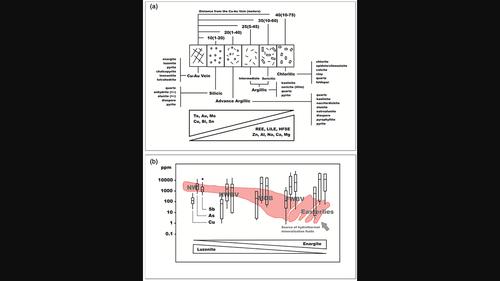菲律宾吕宋岛莱潘托铜金矿蚀变带和铜金矿脉中微量元素和稀土元素分布的矿物学特征
IF 0.8
4区 地球科学
Q3 GEOLOGY
引用次数: 0
摘要
在高硫化系统中,酸性热液会产生广泛的蚀变带,这些蚀变带具有特定的矿物组合/关联以及可识别的元素分布模式。莱潘托铜金矿床呈现出一致的分带模式,即铜金矿脉附近的硅质蚀变向外演化为晚期的闪长岩和闪长岩蚀变,离矿脉最远的地方则为绿泥石蚀变。最近对高硫化铜金矿脉的勘探表明,矿物组合/关联以及元素分布模式提供的补充信息在识别和描述不同蚀变带方面非常有用。在本研究中,我描述了矿物组合/组合的特征,并解释了它们在莱潘托铜金矿床不同蚀变带中的出现情况。主要由绿泥石-橄榄石/黝帘石-方解石-石英-黄铁矿组成的集合体代表了丙绿泥石/绿泥石蚀变带。辉绿岩蚀变带的矿物组合为绢云母-绿泥石-橄榄石-方解石-石英黄铁矿。晚期箭石蚀变带的矿物组合为白云石-高岭石-褐铁矿-透镜石-绢云母-石英-黄铁矿。在硅质蚀变带,矿物组合为石英-绿泥石-透镜石-无水黄铁矿。此外,还介绍了微量元素和稀土元素的分布情况。在微量元素和稀土元素在各蚀变带的分布中,可以观察到从绿泥石蚀变带到硅质蚀变带,Te、Au、Mo、Cu、Sn 和 Bi 的值都有所增加。观察到 REE、LILE(钡、铅、铷、钾)、HFSE(钛、铌、铀、钍)、Al、Na、Ca、Zn、Mn、Co 和 Cd 值相应减少。这项研究还描述了铜金矿脉的矿石矿物组合/组合特征,以及微量元素和稀土元素的分布模式。西北-NOA、悬壁分支矿脉(HWBV)、主矿体(MOB)、脚壁分支矿脉(FWBV)和复活节矿脉一般由恩长石-吕宋岩-黄铁矿-黄铜矿-天王岩-四面体矿-碲矿-黝帘石组成。伴生的煤矸石矿物为无水石膏-天青石-方解石-石英。在不同铜金矿脉的元素分布中,可以观察到铜、砷和锑的值从东向西向西北-北向铜金矿脉下降。所观察到的蚀变和矿石矿物组合/关联的变化对蚀变带和铜金矿脉的元素值分布产生了很大影响。矿物组合/组合和元素分布模式的确定可为莱潘托型铜金矿床的勘探提供可能的指导和参考工具。本文章由计算机程序翻译,如有差异,请以英文原文为准。

Mineralogical attributes to the distribution of trace and rare earth elements in alteration zones and copper‐gold veins in the Lepanto copper‐gold deposit, Luzon, Philippines
In high sulfidation systems, acidic hydrothermal fluids can produce wide alteration zones with specific mineral assemblages/associations as well as identifiable and elemental distribution patterns. The Lepanto Cu‐Au deposit exhibits a consistent zonation pattern of silicic alteration near the Cu‐Au veins evolving outwards to advanced argillic and argillic alteration with chloritic alteration farthest from the vein. Recent exploration of high sulfidation Cu‐Au veins indicated the usefulness of mineralogical assemblages/associations and the complementing information provided by the elemental distribution patterns in the identification and characterization of the different alteration zones. In this study, I characterize the mineral assemblages/associations and interpret their occurrences in the different alteration zones of the Lepanto Cu‐Au deposit. An assemblage that is composed predominantly of chlorite‐epidote/clinozoisite‐calcite‐quartz‐pyrite represents the propylitic/chloritic alteration zone. The argillic alteration has a mineral association of smectite‐sericite‐chlorite‐epidote‐kaolinite‐quartz‐pyrite. The advanced argillic alteration zone has alunite‐kaolinite‐pyrophyllite‐diaspore‐sericite‐quartz‐pyrite as mineral association. In the silicic alteration zone, the mineral association is composed of quartz‐alunite‐diaspore‐anhydrite‐pyrite. Also presented are the distributions of trace and rare earth elements. In the distribution of trace and REEs across alteration zones, there is an observed increase of Te, Au, Mo, Cu, Sn, and Bi values from the chloritic to silicic alteration zones. A corresponding decrease of REE, LILE (Ba, Pb, Rb, K), HFSE (Ti, Nb, U, Th), Al, Na, Ca, Zn, Mn, Co and Cd values are observed. This study also characterizes the ore mineral assemblages/associations of the Cu‐Au veins as well as the distribution patterns of trace and rare earth elements. The Northwest‐NOA, hanging wall branch veins (HWBV), main ore body (MOB), foot wall branch veins (FWBV), and Easterlies are generally made up of enargite‐luzonite‐pyrite‐chalcopyrite‐tennantite‐tetrahedrite‐tellurides‐covellite. The associated gangue minerals are anhydrite‐gypsum‐alunite‐barite‐quartz. In the distribution of elements across the different Cu‐Au veins, there is an observed decrease of Cu, As, and Sb values from the Easterlies towards the Northwest‐NOA Cu‐Au veins. The observed variations in the alteration and ore mineral assemblages/associations have strongly influenced the distribution of elemental values in both alteration zones and Cu‐Au veins. The identification of mineralogical assemblages/associations and elemental distribution patterns may provide possible guides and reference tools in the exploration of Lepanto type Cu‐Au deposits.
求助全文
通过发布文献求助,成功后即可免费获取论文全文。
去求助
来源期刊

Resource Geology
地学-地质学
CiteScore
2.30
自引率
14.30%
发文量
18
审稿时长
12 months
期刊介绍:
Resource Geology is an international journal focusing on economic geology, geochemistry and environmental geology. Its purpose is to contribute to the promotion of earth sciences related to metallic and non-metallic mineral deposits mainly in Asia, Oceania and the Circum-Pacific region, although other parts of the world are also considered.
Launched in 1998 by the Society for Resource Geology, the journal is published quarterly in English, making it more accessible to the international geological community. The journal publishes high quality papers of interest to those engaged in research and exploration of mineral deposits.
 求助内容:
求助内容: 应助结果提醒方式:
应助结果提醒方式:


